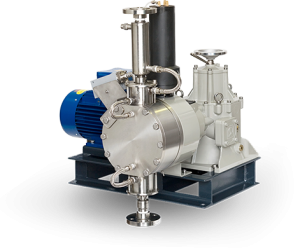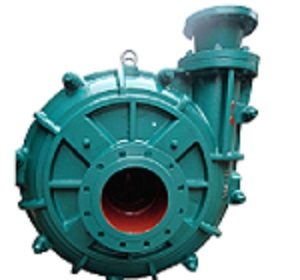Chemical Transfer Pump
In an article entitled Material Transfer Pump, we explain what a material transfer pump is and what its function is. A material transfer pump is a kind of electro-pumps used to transport concentrated or high-viscosity materials.
But thick and high viscosity materials are very versatile and used in different industries for different purposes. Some mistakenly refer to all material transfer pumps as chemical transfer pumps, while chemical transfer pumps are just one of many types of material transfer pumps that of course, widely used in many industries.
Chemical transfer pump is a type of electro pump that is used to transport chemicals or liquids, and is highly resistant to the acidic and alkaline properties of various materials. Since chemicals are highly corrosive and subject to high acid and alkali liquids, parts of these pumps must be selected in such a way that they are compatible with these materials and are not easily damaged.
However, among the various types of material transfer pumps, we find a great variety, some of which are used for the transport of sludge and mineral liquids, some for the paper or laminate industry, etc., and do not need for acid and alkali resistance properties. But they must be resistant to sharp objects or crumbs, etc. This is the key difference between a chemical transfer pump and another concentrated pump.
Types of chemical transfer pumps
In general, the chemical transfer pump is divided into three general categories from a functional point of view:
- Mono pumps
Some chemicals may lose or change in nature as they move or change in speed or impact. Mono-pumps are used for this class of chemicals.
Mono-pumps, also known as progressive cavity pumps, have different dimensions and power and generally do not generate any pulse impacts during chemical transfer, which will not change the nature and properties of the chemical.
Mono pumps can transport chemicals with particulate matter as well as high viscosity up to about 1,000,000 cps. Mono pumps consist of a rotor, stator, gearbox, housing and motor.
- Peristaltic pump
A kind of chemical transfer pump that its works is very interstice. In fact, the basis of this pump is the muscle movements of the human body. As the contractile and pulse movements in the body cause shock and movement in the body, these pumps are observed to cause the contents of the tubes to move.
The peristaltic pump has a chemical resistant rubber tube, which is compressed by a roller bearing, and performs fluid forward movement. It then returns to its original state after being compressed and vacuumed. The Peristaltic Pumps slowly move the chemical fluid, which allows the material to be transported unchanged. Also, in these pumps there is a lack of rubber tube that is connected to the fluid and therefore the fluid will not be contaminated.
- Magnetic actuator pump
Another type of chemical transfer pump is the structure of centrifugal pumps, but the magnetic actuator. In this type of pumps the electric motor of the pump transmits the impulse through the field and the magnetic force.
The Magnetic actuator pump or magnetic drive pump performs its job by removing the mechanical seal or packing in the pump using a two-piece shaft in the seal area. The magnets are located inside the inner shaft, which is in contact with the fluid and is mounted on the shaft. The outer shaft also holds a number of other magnets and is mounted on the power transmission shaft.

Material of Chemical Transmission Pump Parts
The chemical transfer pump must consist of parts that are highly resistant to direct contact with the chemical and corrosive and do not become damaged.
But when we look closely we will find that not all chemicals have the same properties, and their corrosively or acidity vary. This makes it difficult to use a specific or fixed type of materials to build the pump or the internal components of the pump, and in fact it should be given the chemical and even physical nature of each material, taking into account the working conditions of each Manufactured from a variety of chemical transfer pumps, with the material and sex appropriate to the type of activity and nature of the chemical.

Generally used for making parts and materials of chemical transfer pump materials of two categories:
- Metal transfer chemical pump
Stainless steel is commonly used to produce this type of chemical transfer pump, the best and most common of these types being stainless steel. The best type of steel to make a chemical transfer pump can be stainless steel 304 and then 316, 316ti, 316 L. Sometimes alloys such as carpenter or super alloys such as Hastalloy are used and sometimes even elements such as titanium are used for high stability.
These types of pumps do not necessarily use a single metal for the entire pump structure. It can be used to produce body, propeller, seal or shaft etc. with a combination of different metals, which can vary depending on the pump design.
- Synthetic chemical transfer pump
The use of stainless and durable metals is very costly to the customer, and some chemicals are so powerful that the types of these types of metals are not as well resistant. For this reason, synthetic materials should be used in the manufacture of some types of chemical transfer pumps.
Synthetic materials are used to produce chemical transfer pumps in two general modes for the manufacture of pumps or pump components:
– In the first case, these synthetic materials are used to cover metal parts to increase their resistance to chemicals.
– In the latter case, these materials are used to produce pump parts directly, which can be done by injection or industrial molding.
The best materials for coating metallic spacers are the types of rubbers. Rubbers have unique strengths and can withstand high corrosion resistance at very high temperatures. The best type of rubbers to cover metal parts of the material transfer pump can be EPDM, NBR, PU or Viton synthetic rubbers.
But for the manufacture of chemical transfer pump components, generally PVC, PP or PE-like plastics are used.
The use of materials such as ceramics or various polymers has also become commonplace with the advances in technology in recent years for the manufacture or coating of components. Nano-science ceramics or polymers are usually prepared for this purpose, and are usually used either to fabricate parts or to cover metal parts of chemical transfer pumps.
The good thing about using different types of rubber, ceramics and polymers is that you can make a variety of parts and coatings and choose the best for any type of chemical.
One of the biggest challenges for the manufacturers of material transfer pumps and especially chemical transfer pumps due to the range and variety of components used in their manufacture can be considered their sealing method.
Issues such as pumping type, pump operating conditions, temperature, solid and sharp particles, acidity, toxicity, concentration, fluidity, etc. are among the factors that challenge the choice of the best sealing components.
But usually the best type of sealing parts can be single mechanical seal or double mechanical seal coupling, each of which may be made of different type’s materials for best sealing.

Chemical Coupling Pump with Magnetic Coupler
The best type of sealing material for a pump can be the use of magnetic coupling instead of other seals with other materials. These types of couplings are generally very durable and eliminate any risk of leakage of toxic or highly corrosive materials and therefore have great application for chemical transfer pumps.
While using this type of magnetic coupling, the propeller shaft is located inside the pump housing, and the torque transfer is carried out by the magnetic field and is well resistant to corrosive chemicals.
Important tips for buying a chemical transfer pump
There are three crucial factors in choosing a chemical transfer pump that you must specify before you buy a chemical transfer pump:
- Material needed for transportation
When buying a chemical transfer pump, the most important thing to know is what kind of material you are going to transfer with the pump. How corrosive and alkaline or toxic is the substance? And what is their variety?
By correctly identifying the materials or liquids you are about to transport, you can choose the best material for your chemical transfer pump. This will not only reduce the amount of corrosion and damage to the pump, it will also prevent possible reactions inside the pump with other materials. Sometimes you may need to customize the pump you want.
- Pump size and performance of chemical transfer pump
One of the most important things that is sometimes forgotten and only when choosing a chemical transfer pump to be careful about the type of chemical is the pump’s performance and power. The pump performance and power must be calculated in minutes and taken into account.
It depends on your needs. So you need to estimate in advance how much input and output you need for your factory or target. Finally, to what extent can your chemical transfer pump meet this need? With this in mind, you can provide a chemical pump with a higher power than you need, sure a little higher than you need to be.
- Function of chemical transfer pump
Chemical transfer pumps may be of magnetic, centrifuge, mono-pump or peristaltic models, each depending on the type of chemical transfer. In fact, you need to determine which type of pump function is the best choice for the chemical you are looking for, which will not change the properties of the chemical or make it more resistant to exposure when exposed to the chemical.
JAMIN Tarhe Parsian (JTP) Industrial Group, as one the first company producing all kinds of pumps, including chemical transfer pumps in Iran, is ready to provide specialized advice to its domestic and foreign customers. If you need to choose any type of chemical pump you can ask our experts questions and concerns and order the best pump according to your needs and at a very affordable price.
Meanwhile, this feature has been developed at JTP Company so that our customers can achieve their customized demands in the shortest time. With the explanation that it is possible to design and manufacture different types of chemical transfer pumps to suit different applications and needs in this complex.







